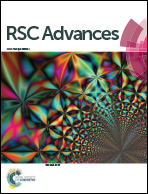Injectable conducting interpenetrating polymer network hydrogels from gelatin-graft-polyaniline and oxidized dextran with enhanced mechanical properties
Abstract
Electrically conductive hydrogels have great potential for biomedical applications. However, they usually exhibited poor mechanical properties. We present a simple approach to prepare injectable conductive interpenetrating polymer network (IPN) hydrogels with enhanced mechanical properties. The in situ forming IPN conductive hydrogels were based on gelatin-graft-polyaniline and carboxymethyl-chitosan, which were crosslinked with oxidized dextran via Schiff base at physiological conditions. Storage modulus of the injectable conductive IPN hydrogels was greatly increased. Gelation time, swelling ratio, pore size and conductivity of these injectable hydrogels were adjusted by polyaniline content. Electroactivity of the hydrogels was studied by UV-vis and cyclic voltammetry. Cytocompatibility of the hydrogels was investigated by cell adhesion and proliferation of C2C12 myoblasts and adipose-derived mesenchymal stem cells. The in vivo biocompatibility of the hydrogels was confirmed by H&E staining. These injectable conductive hydrogels with good mechanical properties and biocompatibility as bioactive biomaterials have great potential for drug delivery and tissue engineering.


 Please wait while we load your content...
Please wait while we load your content...